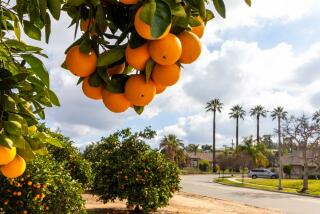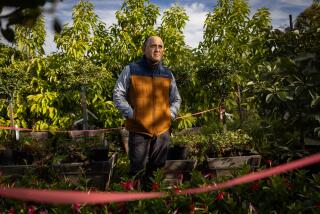A disease that could devastate citrus growers has reached San Bernardino County
An economically devastating citrus disease has been detected for the first time in San Bernardino County, expanding an already large quarantine area aimed at keeping the malady from hitting the commercial groves centered in the southern San Joaquin Valley, according to California agricultural authorities.
Just one tree near the city of Montclair was stricken with citrus greening disease, or Huanglongbing, a bacterial infection spread by a tiny insect, the Asian citrus psyllid, according to the state Department of Food and Agriculture.
An existing quarantine sparked by previous detections in Los Angeles and Orange counties has been expanded by 93 square miles, creating a contiguous 1,015-square-mile area. Another quarantine is in effect in Riverside County.
The measure imposes strict prohibitions on transporting citrus trees and fruit. No fruit that is not commercially cleaned and packed, including residential citrus, can be moved from the property on which it is grown, although it may be processed or consumed on the premises.
Officials plan to inspect and spray citrus trees within 400 meters of the infected tree in San Bernardino County.
The HLB bacteria attack the citrus tree’s vascular system, resulting in fruit that is hard, bitter and misshapen. They do not pose a health threat to humans.
Authorities confirmed the first California case of HLB in Hacienda Heights in 2012, and again in 2015 in San Gabriel, about 20 miles away. Both were residential areas.
California’s nearly $4-billion citrus industry has been concerned about the spread of the disease since it first was detected in Florida, in 2005, about seven years after the psyllid was first found there. Federal, state and private efforts to combat it include releasing an exotic wasp that preys on the psyllid, as well as genetic engineering of citrus trees to add disease-fighting capabilities.
The first psyllids in California were found in the U.S.-Mexico border region of San Diego and Imperial counties in 2008 and have crept northward, largely aided by people transporting infested trees and fruit, according to the U.S. Department of Agriculture.
California Department of Food and Agriculture officials are urging anyone who suspects insect or bacterial infestation to call the agency’s toll-free pest hot line at (800) 491-1899 or visit its website.







